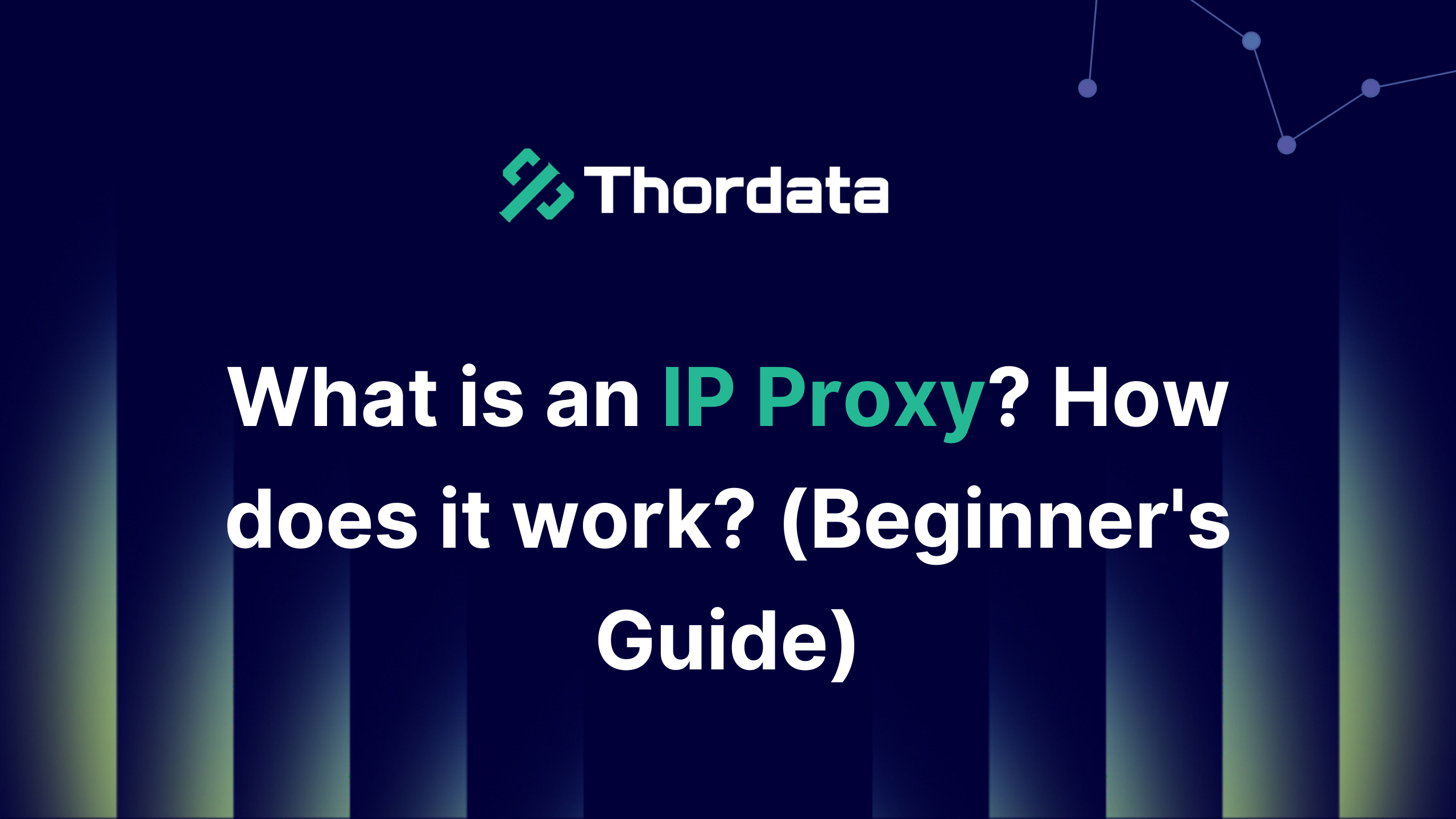What is an IP Proxy? How does it work? (Beginner Guide)


If you’ve ever tried to access geo-restricted content, protect your online privacy, or scrape data from a website, then you’ve most likely come across the term “IP proxy.” But what exactly is an IP proxy? How does it work? In this guide, we’ll detail everything you need to know about IP proxies, including their types, benefits, use cases, and how to choose the right one for your needs.
What is an IP proxy?
An IP proxy, often referred to simply as a “proxy server,” acts as an intermediary between your device and the Internet. When you use a proxy, your Internet requests go through the proxy server before reaching the final destination. Therefore, the destination website sees the proxy server’s IP address instead of your real IP address.
Think of it as a digital middleman: instead of your traffic going directly from your device to a website, it first goes through a proxy server, which makes the request on your behalf and then forwards the response to you.
Why is your IP address so important?
Every device connected to the internet is assigned an IP (Internet Protocol) address, which functions like a digital home address. This address can reveal information such as your general location, your internet service provider (ISP), and even your browsing habits. Websites, apps, and online services use IP addresses for a variety of purposes, including
Geo-targeting content
Enforcing regional restrictions
Limiting access based on location
Tracking user behavior
By using an IP proxy, you can hide your real IP address and make it appear that you are accessing the Internet from another location.

How does an IP proxy work?
Here’s a step-by-step breakdown of how a basic IP proxy works:
1. User Request: You type in a URL or send a request from your browser.
2. Proxy Server: Instead of the request going directly to the website, it first goes to the proxy server.
3. Forwarding the Request: The proxy server then sends the request to the target website using its own IP address.
4. Receiving the Response: The website sends the requested content back to the proxy.
5. Returning the Data: The proxy server forwards the data back to your device.
During this process, the destination website only sees the proxy server’s IP, not yours.
Types of IP Proxy
There are several types of IP proxies, each with specific features and use cases:
1. Residential Proxy
Assigned by ISPs to real residential users. Appears as a legitimate user on websites. Harder to detect and block.
Best for: Web scraping, ad verification, and social media management.
2. Datacenter Proxy
Hosted in data centers, not distributed to real users. Faster and cheaper than residential proxies. But easier to detect and block.
Best suited for batch tasks and high-speed operations.
3. Mobile Proxy
Uses IP addresses assigned to mobile devices over 3G/4G/5G networks, making them extremely difficult to detect.
Perfect for application, automation, and mobile testing.
4. Rotating Proxy
Automatically switch IP addresses at set intervals or on request.
Ideal for large-scale web scraping and crawling.
5. Static Proxy
Maintain the same IP address throughout the session.
Useful when you need a consistent online identity.
Common use cases for IP proxies
IP proxies have a wide range of uses across industries. Here are some common use cases:
Bypassing Geo-Restrictions
Want to watch shows that are only available in another country? An IP proxy can make it appear as if you’re browsing from that region, unlocking access to geo-restricted content.
Web Scraping and Data Collection
Businesses use proxy servers to collect public data from websites without being blocked or rate-limited. This is essential for price monitoring, competitor analysis, and SEO tracking.
Ad Verification
Advertisers use proxy servers to check whether their ads are running properly in different regions and to prevent ad fraud.
Anonymous browsing
Worried about privacy? Proxy servers help hide your real IP address, protecting you from tracking and surveillance.
Social Media and Account Management
Digital marketers manage multiple social media accounts by assigning a unique proxy server to each account to avoid detection and a ban.
E-commerce and market research
Online retailers use proxy servers to monitor prices in different regions, check inventory availability, and analyze market trends without being flagged by competitors.
Advantages of using an IP proxy
Privacy & Anonymity: Protect your identity and browsing habits.
Access Control: Bypass geo-blocking and censorship.
Improved performance: In some cases, proxies can cache content and improve loading times.
Security: Malicious content can be filtered out before it enters your network.
IP proxy: Potential risks and precautions
Although an IP proxy has many advantages, there are also some risks to consider:
Free proxies: These are usually unreliable and may leak your data.
Abuse: Using the proxy for illegal or unethical purposes may result in account suspension or legal consequences.
Detection: Poor-quality or overused proxies are easily identified and blocked.
Be sure to choose a reputable proxy provider with a clear ethical use policy.
How to choose the right IP proxy
When choosing a proxy, consider the following:
Purpose: Be clear about what you need the proxy for (e.g., scraping data, streaming media, managing accounts).
Location coverage: Make sure the proxy provider covers your target area.
Speed and reliability: Choose a provider with high uptime and fast response times.
IP Type: Select Residential, Data Center, or Mobile based on your usage scenario.
Compliance: Ensuring the proxy network meets legal and ethical standards.
Setup Guide for IP Proxies
Choose a Provider: Research and choose a trustworthy proxy service.
Set up proxy: Configure your device or software with the proxy IP and port.
Test the connection. Use a tool like My IP Address Checker to make sure your proxy server is working properly.
Use Responsibly: Comply with all legal guidelines and terms of service.
Troubleshooting common proxy issues
If you experience issues with IP Proxy, consider the following troubleshooting tips:
Check your proxy settings: Make sure the proxy settings on your device or browser are configured correctly.
Test different proxies: If one proxy doesn’t work, try using a different proxy server.
Clear your browser cache: Sometimes cached data can cause issues. Clear your browser cache and cookies to resolve potential conflicts.
Disable Firewall/Antivirus Software: Firewall or Antivirus software may be blocking the proxy connection. Temporarily disable them to see if the problem is resolved.
Contact customer service: If the problem persists, contact your proxy provider’s customer service for assistance.
Conclusion
IP proxy servers are powerful tools that can increase access, privacy, and data freedom on the Internet. Whether you are a casual user who wants to browse privately or a business looking to scale your data operations, understanding how proxy servers work is the first step to using them effectively.
When integrating proxies into your digital strategy, it’s important to prioritize ethical use, secure providers, and clear goals.
Frequently asked questions
Are there free proxies?
Yes, free proxies do exist and are widely available online. However, they often have limitations such as slow speeds, lack of encryption, spotty uptime, and potential security or privacy risks. They are not recommended.
Are web proxies illegal?
Web proxies themselves are not illegal. They are a legal tool for protecting privacy, controlling access, and content delivery. However, using proxies for illegal activities such as hacking, fraud, or circumventing local laws may result in legal consequences.
Do proxies hide your IP address?
Yes, proxies hide your real IP address by routing your internet traffic through different servers. The websites you visit will see the IP address of the proxy server instead of yours.
About the author
Yulia is a dynamic content manager with extensive experience in social media, project management, and SEO content marketing. She is passionate about exploring new trends in technology and cybersecurity, especially in data privacy and encryption. In her free time, she enjoys relaxing with yoga and trying new dishes.
The thordata Blog offers all its content in its original form and solely for informational intent. We do not offer any guarantees regarding the information found on the thordata Blog or any external sites that it may direct you to. It is essential that you seek legal counsel and thoroughly examine the specific terms of service of any website before engaging in any scraping endeavors, or obtain a scraping permit if required.